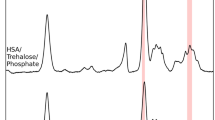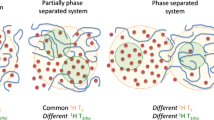ABSTRACT
Purpose
To relate NMR relaxation times to instability-related molecular motions of freeze-dried protein formulations and to examine the effect of sugars on these motions.
Methods
Rotating-frame spin-lattice relaxation time (T1ρ) was determined for both protein and sugar carbons in freeze-dried lysozyme-sugar (trehalose, sucrose and isomaltose) formulations using solid-state 13C NMR.
Results
The temperature dependence of T1ρ for the lysozyme carbonyl carbons in lysozyme with and without sugars was describable with a model that includes two different types of molecular motion with different correlation times (τc) for the carbon with each τc showing Arrhenius temperature dependence. Both relaxation modes have much smaller relaxation time constant (τc) and temperature coefficient (Ea) than structural relaxation and may be classified as β-relaxation and γ-relaxation. The τc and Ea for γ-relaxation were not affected by sugars, but those for β-relaxation were increased by sucrose, changed little by trehalose, and decreased by isomaltose, suggesting that the β-mobility of the lysozyme carbonyl carbons is decreased by sucrose and increased by isomaltose.
Conclusion
T1ρ determined for the lysozyme carbonyl carbons can reflect the effect of sugars on molecular mobility in lysozyme. However, interpretation of relaxation time data is complex and may demand data over an extended temperature range.









Similar content being viewed by others
Notes
This statement is equivalent to stating that the motion represented by the relaxation process may have nothing directly to do with the motion required for degradation, if the “coupling coefficient” relating a relaxation time constant for a given microstate with degradation within that microstate, which has been discussed in a reference (6), is much less than unity.
REFERENCES
Yoshioka S, Aso Y. Correlation between molecular mobility and chemical stability during storage of amorphous pharmaceuticals. J Pharm Sci. 2007;96:960–81.
Craig DQM, Royall PG, Kett VL, Hopton ML. The relevance of the amorphous state to pharmaceutical dosage forms: glassy drugs and freeze dried systems. Int J Pharm. 1999;179:179–207.
Wang W. Lyophilization and development of solid protein pharmaceuticals. Int J Pharm. 2000;203:1–60.
Parker R, Gunning YM, Lalloué B, Noel TR, Ring SG. Glassy state dynamics, its significance for biostabilization and role of carbohydrates. In: Levine H, editor. Amorphous food and pharmaceutical systems. Cambridge: The Royal Society of Chemistry; 2002. p. 73–87.
Pikal MJ. Chemistry in solid amorphous matrices: implication for biostabilization. In: Levine H, editor. Amorphous food and pharmaceutical systems. Cambridge: The Royal Society of Chemistry; 2002. p. 257–72.
Pikal MJ. Mechanisms of protein stabilization during freeze-drying and storage: the relative importance of thermodynamic stabilization and glassy state relaxation dynamics. In: Rey L, May JC, editors. Freeze-drying/lyophilization of pharmaceutical and biological products. 2nd ed. New York: Marcel Dekker Inc; 2004. p. 63–107.
Shamblin SL. The role of water in physical transformations in freeze-dried products. In: Costantino HR, Pikal MJ, editors. Lyophilization of biopharmaceuticals. Arlington: AAPS; 2004. p. 229–70.
Lechuga-Ballesteros D, Miller DP, Dudddu SP. Thermal analysis of lyophilized pharmaceutical peptide and protein formulations. In: Costantino HR, Pikal MJ, editors. Lyophilization of biopharmaceuticals. Arlington: AAPS; 2004. p. 271–335.
Stots CE, Winslow SL, Houchin ML, D’Souza AJM, Ji J, Topp EM. Degradation pathways for lyophilized peptides and proteins. In: Costantino HR, Pikal MJ, editors. Lyophilization of biopharmaceuticals. Arlington: AAPS; 2004. p. 443–79.
Sun WQ, Davidson P, Chan HSO. Protein stability in the amorphous carbohydrate matrix: relevance to anhydrobiosis. Biochim Biophys Acta. 1998;1425:245–54.
Yoshioka S, Aso Y, Nakai Y, Kojima S. Effect of high molecular mobility of poly(vinyl alcohol) on protein stability of lyophilized γ-globulin formulations. J Pharm Sci. 1998;87:147–51.
Yoshioka S, Tajima S, Aso Y, Kojima S. Inactivation and aggregation of β-galactosidase in lyophilized formulation described by Kohlrausch-Williams-Watts stretched exponential function. Pharm Res. 2003;20:1655–60.
Lai MC, Hageman MJ, Schowen RL, Borchardt RT, Laird BB, Topp EM. Chemical stability of peptide in polymers. 2. Discriminating between solvent and plasticizing effects of water on peptide deamidation in poly(vinylpyrrolidone). J Pharm Sci. 1999;88:1081–9.
Yoshioka S, Aso Y, Kojima S. Temperature- and glass transition temperature-dependence of bimolecular reaction rates in lyophilized formulations described by the Adam-Gibbs-Vogel equation. J Pharm Sci. 2004;93:1062–9.
Guo Y, Byrn SR, Zografi G. Physical characteristics and chemical degradation of amorphous quinapril hydrochloride. J Pharm Sci. 2000;89:128–43.
Yoshioka S, Aso Y. A quantitative assessment of the significance of molecular mobility as a determinant for the stability of lyophilized insulin formulations. Pharm Res. 2005;22:1358–64.
Yoshioka S, Miyazaki T, Aso Y. Degradation rate of lyophilized insulin, exhibiting an apparent arrhenius behavior around glass transition temperature regardless of significant contribution of molecular mobility. J Pharm Sci. 2006;95:2684.
Yoshioka S, Aso Y, Miyazaki T. Negligible contribution of molecular mobility to the degradation rate of insulin lyophilized with poly(vinylpyrrolidone). J Pharm Sci. 2006;95:939–43.
Strickley RG, Anderson BD. Solid-state stability of human insulin II. Effect of water on reactive intermediate partitioning in lyophiles from pH 2–5 solutions: stabilization against covalent dimer formation. J Pharm Sci. 1997;86:645–53.
Yoshioka S, Miyazaki T, Aso Y. β-relaxation of insulin molecule in lyophilized formulations containing trehalose or dextran as a determinant of chemical reactivity. Pharm Res. 2006;23:961–6.
Chang L, Shepherd D, Sun J, Ouellete D, Grant KL, Tang X, et al. Mechanism of protein stabilization by sugar during freeze-drying and storage: native structure preservation, specific interaction, and/or immobilization in a glassy matrix? J Pharm Sci. 2005;94:1427–44.
Cicerone MS, Soles C. Fast dynamics and stabilization of proteins: binary glasses of trehalose and glycerol. Biophys J. 2004;86:3836–45.
Cicerone MT, Soles CL, Chowdhuri Z, Pikal MJ, Chang LL. Fast dynamics as a diagnostic for excipients in preservation of dried proteins. Am Pharm Rev. 2005;8:24–7.
Yoshioka S, Miyazaki T, Aso Y, Kawanishi T. Significance of local mobility in aggregation of β-galactosidase lyophilized with trehalose, sucrose or stachyose. Pharm Res. 2007;24:1660–7.
Matsuo M, Bin Y, Xu C, Ma L, Nakaoki T, Suzuki T. Relaxation mechanism in several kinds of polyethylene estimated by dynamic mechanical measurements, positron annihilation, X-ray and 13C solid-state NMR. Polymer. 2003;44:4325–40.
Aso Y, Yoshioka S. Effect of freezing rate on physical stability of lyophilized cationic liposomes. Chem Pharm Bull. 2005;53:301–4.
Andronis V, Zografi G. Molecular mobility of supercooled amorphous indomethacin, determined by dynamic mechanical analysis. Pharm Res. 1991;14:410–4.
Liu J, Rigsbee DR, Stotz C, Pikal MJ. Dynamics of pharmaceutical amorphous solids: the study of enthalpy relaxation by isothermal microcalorimetry. J Pharm Sci. 2002;91:1853–62.
Shamblin SL, Tang X, Chang L, Hancock BC, Pikal MJ. Characterization of the time scales of molecular motion in pharmaceutically important glasses. J Phys Chem B. 1999;103:4113–21.
Kumagai H, Sugiyama T, Iwamoto S. Effect of water content on dielectric relaxation of gelatin in a glassy state. J Agric Food Chem. 2000;48:2260–5.
Yoshioka S, Aso Y. Glass transition- related changes in molecular mobility below glass transition temperature of freeze-dried formulations, as measured by dielectric spectroscopy and solid state nuclear magnetic resonance. J Pharm Sci. 2005;94:275–87.
Ermolina I, Polygalov E, Bland C, Smith G. Dielectric spectroscopy of low-loss sugar lyophiles: II. Relaxation mechanisms in freeze-dried lactose and lactose monohydrate. J Non-Crystalline Solids. 2007;353:4485–91.
Correia NT, Ramos JJM, Descamps M, Collins G. Molecular mobility and fragility inindomethacin: a thermally stimulated depolarization current study. Pharm Res. 2001;18:1767–74.
Pikal MJ, Rigsbee D, Roy ML, Galreath D, Kovach KJ, Wang B, et al. Solid state chemistry of proteins: II. the correlation of storage stability of freeze-dried human growth hormone (hGH) with structure and dynamics in the glassy solid. J Pharm Sci. 2008;97:5106–21.
Yoshioka S, Aso Y, Kojima S, Sakurai S, Fujiwara T, Akutsu H. Molecular mobility of protein in lyophilized formulations linked to the molecular mobility of polymer excipients, as determined by high resolution 13C solid-state NMR. Pharm Res. 1999;16:1621–5.
Aso Y, Yoshioka S, Zhang J, Zografi G. Effect of water on the molecularmobility of sucrose and poly(vinylpyrrolidone) in a colyophilized formulation as measured by 13C-NMR relaxation time. Chem Pharm Bull. 2002;50:822–6.
Latosinska JN, Latosinska M, Utrecht R, Mielcarek S, Pietrzak J. Molecular dynamics of solid benzothiadiazine derivatives (Thiazides). J Molecular Structure. 2004;694:211–7.
Niehaus Jr WG, Ryhage R. Determination of double bond positions in polyunsaturated fatty acids by combination gas chromatography-mass spectrometry. Anal Chem. 1968;40:1840–7.
Bielecki A, Burum DP. Temperature dependence of 207Pb MAS spectra of solid lead nitrate. An accurate, sensitive thermometer for variable-temperature MAS. K Magnetic Res Ser A. 1995;116:215–20.
Pfeffer PE, Odier L, Dudley RL. Assignment of 13C CPMAS NMR spectra of crystalline methyl β-D-glucopyranoside and sucrose using deuterium labeling and interrupted proton decoupling. J Carbohydrate Chem. 1990;9:619–29.
Wang B, Cicerone MT, Aso Y, Pikal MJ. The impact of thermal treatment on the stability of freeze-dried amorphous pharmaceuticals: II. Aggregation in an IgG1 fusion protein. J Pharm Sci. 2010;99:683–700.
Iijima T, Mizuno M, Suhara M, Endo K. Molecular and electron-spin dynamics in [M(H2O)6][AB6] as studied by solid state NMR. Bunseki Kagaku. 2003;52:157–63.
Horii F. NMR relaxation and dynamics. In: Ando I, Asakura T, editors. Solid state NMR of polymers. Amsterdam: Elsevier; 1998. p. 51–81.
Author information
Authors and Affiliations
Corresponding author
Rights and permissions
About this article
Cite this article
Yoshioka, S., Forney, K.M., Aso, Y. et al. Effect of Sugars on the Molecular Motion of Freeze-Dried Protein Formulations Reflected by NMR Relaxation Times. Pharm Res 28, 3237–3247 (2011). https://doi.org/10.1007/s11095-011-0512-8
Received:
Accepted:
Published:
Issue Date:
DOI: https://doi.org/10.1007/s11095-011-0512-8




